Autonomous spaceport drone ship
 Of Course I Still Love You carries the first rocket that successfully landed on a drone ship (Falcon 9 FT, CRS-8 mission, 8 April 2016). | |||||||||||||||||||||||||||||||||||||||||||||
| Launch site |
| ||||||||||||||||||||||||||||||||||||||||||||
|---|---|---|---|---|---|---|---|---|---|---|---|---|---|---|---|---|---|---|---|---|---|---|---|---|---|---|---|---|---|---|---|---|---|---|---|---|---|---|---|---|---|---|---|---|---|
| Location |
| ||||||||||||||||||||||||||||||||||||||||||||
| Short name | ASDS | ||||||||||||||||||||||||||||||||||||||||||||
| Operator | SpaceX | ||||||||||||||||||||||||||||||||||||||||||||
| Launch pad(s) | 4 oceangoing landing platforms (2 active; 1 in production; 1 retired) | ||||||||||||||||||||||||||||||||||||||||||||
| |||||||||||||||||||||||||||||||||||||||||||||
An autonomous spaceport drone ship (ASDS) is an ocean-going vessel derived from a deck barge, outfitted with station-keeping engines and a large landing platform and is controlled by an autonomous robot. Construction of such ships was commissioned by aerospace company SpaceX to allow for recovery of rocket first-stages at sea for missions which do not carry enough fuel to return to the launch site after boosting spacecraft onto an orbital trajectory.[1][2]
SpaceX has two operational drone ships and has a third under construction as of early 2018. Just Read the Instructions operates in the Pacific for launches from Vandenberg; Of Course I Still Love You operates in the Atlantic for launches from Cape Canaveral. A Shortfall of Gravitas is under construction. As of 5 December 2019[update], 34 Falcon 9 flights have attempted to land on a drone ship, with 27 of them succeeding (79%).
The ASDS ships are a key early operational component in the SpaceX objective to significantly lower the price of space launch services through "full and rapid reusability,"[3] and were developed as part of the multi-year reusable rocket development program SpaceX undertook to engineer the technology. Any Falcon flights going to geostationary orbit or exceeding escape velocity require landing at sea, encompassing about half of SpaceX missions.[4]
History
In 2009, SpaceX CEO Elon Musk articulated ambitions for "creating a paradigm shift in the traditional approach for reusing rocket hardware."[5] In October 2014, SpaceX publicly announced that they had contracted with a Louisiana shipyard to build a floating landing platform for reusable orbital launch vehicles. Early information indicated that the platform would carry an approximately 90-by-50-meter (300 ft × 160 ft) landing pad and would be capable of precision positioning so that the platform could hold its position for launch vehicle landing.[6][7] On 22 November 2014 Musk released a photograph of the "autonomous spaceport drone ship" along with additional details of its construction and size.[5][8]
As of December 2014, the first drone ship used, the McDonough Marine Service's Marmac 300 barge, was based in Jacksonville, Florida, at the northern tip of the JAXPORT Cruise Terminal where SpaceX built a stand to secure the Falcon stage during post-landing operations. The stand consists of four 15,000 lb (6,800 kg), 107 in (270 cm) tall and 96.25 in (244.5 cm) wide pedestal structures bolted to a concrete base. A mobile crane lifted the stage from the ship and placed it on the stand. Tasks such as removing or folding back the landing legs prior to placing the stage in a horizontal position for trucking occurred there.[9]
The ASDS landing location for the first landing test was in the Atlantic approximately 200 miles (320 km) northeast of the launch location at Cape Canaveral, and 165 miles (266 km) southeast of Charleston, South Carolina.[3][10]

On 23 January 2015, during repairs to the ship following the unsuccessful first test, Musk announced that the ship was to be named Just Read the Instructions,[11] with a sister ship planned for west coast launches to be named Of Course I Still Love You.[12] On 29 January, SpaceX released a manipulated photo of the ship with the name illustrating how it would look once painted.[13] Both ships are named after two General Contact Units, spaceships commanded by autonomous artificial intelligences, that appear in The Player of Games, a Culture novel by Iain M. Banks.[14]
The first Just Read the Instructions was retired in May 2015 after approximately six months of service in the Atlantic, and its duties were assumed by Of Course I Still Love You.[15] The former ASDS was modified by removing the wing extensions that had extended the barge surface and the equipment (thrusters, cameras, and communications gear) that had been added to refit it as an ASDS; these items were saved for future reuse.[15] In 2018, SpaceX announced plans for a fourth barge, A Shortfall of Gravitas.[16]
The active ASDS fleet
In early 2015, SpaceX leased two additional deck barges—Marmac 303 and Marmac 304—and initiated refit to construct two additional autonomous-operation-capable ASDS ships, built on the hulls of these Marmac barges.
Of Course I Still Love You

The second ASDS barge, Of Course I Still Love You (OCISLY), had been under construction in a Louisiana shipyard since early 2015 using a different hull—Marmac 304—in order to service launches on the east coast. It was built as a replacement for the first Just Read the Instructions and entered operational service for Falcon 9 Flight 19 in late June 2015. As of June 2015, its home port was Jacksonville, Florida,[12][15] but after December 2015, it was transferred 160 miles (260 km) further south, at Port Canaveral.
While the dimensions of the ship are nearly identical to the first ASDS, several enhancements were made including a steel blast wall erected between the aft containers and the landing deck. The ship was in place for a first-stage landing test on the CRS-7 mission, which failed on launch on 28 June 2015.[15]
On 8 April 2016 the first stage, which launched the Dragon CRS-8 spacecraft, successfully landed for the first time ever on OCISLY, which is also the first ever drone ship landing.[17]
In February 2018, the Falcon Heavy Test Flight's central core exploded upon impact next to OCISLY that damaged two of the four thrusters on the drone ship.[18] Two thrusters were removed from the Marmac 303 barge in order to repair OCISLY.[19]

Just Read the Instructions
The first and third (using parts from the original Marmac 300 hull/barge under the same title Just Read the Instructions (JRtI), the original was scrapped after the CRS-6 landing failure) ASDS barge, using the Marmac 303 hull, was built during 2015 in a Louisiana shipyard, and the barge transited the Panama Canal in June 2015 carrying its wing extensions as cargo on the deck because the ASDS, when complete, would be too wide to pass through the canal.[15][12]
The home port for the Marmac 303 was untilAugust 2019 the Port of Los Angeles, at the AltaSea marine research and business campus in San Pedro's outer harbor.[20] The landing platform and tender vessels began docking there in July 2015 in advance of the main construction of the AltaSea facilities.[21][22]
SpaceX announced that the Marmac 303 would be the second ASDS to be named Just Read the Instructions in January 2016, shortly before its first use as a landing platform for Falcon 9 Flight 21.[23]
On 17 January 2016, JRtI was put to first use in an attempt to recover a Falcon 9 first-stage booster from the Jason-3 mission from Vandenberg.[15] The booster successfully landed on the deck; however, a lockout collet failed to engage on one of the legs causing the rocket to tip over, exploding on impact with the deck.[24] On 14 January 2017, SpaceX launched Falcon 9 Flight 29 from Vandenberg and landed the first stage on the JRtI that was located about 370 km (230 mi) downrange in the Pacific Ocean, making it the first successful landing in the Pacific.[25]
In August 2019, JRtI left the Port of Los Angeles to be towed to the Gulf of Mexico; it transited through the Panama Canal.[26] JRtI arrived in Morgan City, Louisiana in late August and stayed there until December 1 when she moved to her new homeport at Cape Canaveral, where her sister ship OCISLY is operating at.
Under construction
SpaceX announced a fourth ASDS in early 2018.[27]
A Shortfall of Gravitas
The fourth ASDS was announced to be under construction in February 2018 and its location will later be determined. It is named A Shortfall of Gravitas (ASoG) and like the rest of the fleet, its naming is based on names used in the Culture series.[27][28]
Characteristics
| History | |
|---|---|
| Name | Just Read the Instructions[13] |
| Owner | McDonough Marine Service |
| Operator | SpaceX |
| In service | November 2014 |
| Out of service | May 2015 |
| Status | Retired |
| General characteristics as drone ship (2014–present) | |
| Length | 300 ft (91 m)[30] |
| Beam | 170 ft (52 m)[30] |
| Depth | 19.8 ft (6 m)[31] |
| Installed power | Generator units |
| Propulsion | 4 × 300 hp (220 kW) azimuth thrusters with 1 m (40 in) nozzles, as of January 2015[update][29] |
| Notes | Autonomous or remote-controlled operation modes are available during rocket landing operations[3] |

The ASDS are autonomous vessels capable of precision positioning, originally stated to be within 3 meters (9.8 ft) even under storm conditions,[8] using GPS position information[32] and four diesel-powered azimuth thrusters.[33] In addition to the autonomous operating mode, the ships may also be telerobotically controlled.[3]
The azimuth thrusters are hydraulic propulsion outdrive units with modular diesel-hydraulic-drive power units manufactured by Thrustmaster, a marine equipment manufacturer in Texas.[5] The returning rocket must not only land within the confines of the deck surface but must also deal with ocean swells and GPS errors.[5][34]
SpaceX equips the ships with a variety of sensor and measurement technology to gather data on the booster returns and landing attempts, including commercial off the shelf GoPro cameras.[35]
At the center of the ASDS landing pads is a circle that encloses the SpaceX stylized "X" in an X-marks-the-spot landing point.[36]
Naming
The two ASDS names used so far, Just Read the Instructions (JRtI), and Of Course I Still Love You (OCISLY), pay homage to the works of the late science fiction author Iain M. Banks by being based on his Culture fictional universe.[37] Both JRtI and OCISLY are names of enormous, sentient starships, which appeared in the novel The Player of Games.[38] The third name that will be used for the fourth ASDS will be A Shortfall of Gravitas (ASoG) that is similarly drawn from the Culture-milieu of Iain M. Banks.[39] The Culture series has a running gag on having some starships that include "Gravitas" within their names.[40]
Just Read the Instructions (Marmac 300)
The landing platform of the upper deck of the first barge named Just Read the Instructions was 52 m × 91 m (170 ft × 300 ft) while the span of the Falcon 9 v1.1 landing legs was 18 m (60 ft).[5][34] The vessel was retired in 2015.[15]
Of Course I Still Love You (Marmac 304)
Of Course I Still Love You was built as a refit of the barge Marmac 304 for landings in the Atlantic Ocean. Its homeport is in Port Canaveral, Florida since December 2015, after being ported for a year at the Port of Jacksonville during most of 2015.
Just Read the Instructions (Marmac 303)
Just Read the Instructions, the second barge with that name, was built as a refit of the barge Marmac 303 in 2015 for landings in the Pacific Ocean. Its homeport was in the Port of Los Angeles, California from 2015 to 2019[41] but in August 2019 it was moved to the Gulf of Mexico.[26] In December 2019 it was moved to Cape Canaveral.
A Shortfall of Gravitas (under construction)
The fourth ASDS is named A Shortfall of Gravitas, is under construction as of early 2018.
Operation
A tug is used to bring the ASDS to its oceanic position, and a support ship stands by some distance away from the crewless ASDS. The vessels initially used on the east coast were Elsbeth III (tug) and GO Quest (support).[42] Following landing, technicians and engineers typically board the landing platform, and secure the rocket's landing legs to lock the vehicle in place for transport back to port.[3] The rocket stage is secured to the deck of the drone ship with steel hold downs welded on to the feet of the landing legs.[43] In June 2017, OCISLY started being deployed with a robot that drives under the rocket and grabs onto the hold-down clamps located on the outside of the Falcon 9's structure after landing.[44] Fans call the robot "Optimus Prime" or "Roomba," the latter of which has been turned into a backronym for "Remotely Operated Orientation and Mass Balance Adjustment."[45]
Vessel missions

The first flight test was 10 January 2015[46] when SpaceX conducted a controlled-descent flight test to land the first-stage of Falcon 9 Flight 14 on a solid surface after it was used to loft a contracted payload toward Earth orbit.[6][7] SpaceX projected prior to the first landing attempt that the likelihood of successfully landing on the platform would be 50 percent or less.[5][7] The landings went from being landing tests towards being routine parts of missions.
| No. | Date | Mission | ASDS landing mission description | Landing result | Image |
|---|---|---|---|---|---|
| 1 | 10 January 2015 | SpaceX CRS-5 | SpaceX attempted a landing during SpaceX CRS-5 on Just Read the Instructions on 10 January 2015. Many of the test objectives were achieved, including precision control of the rocket's descent to land on the platform at a specific point in the North Atlantic Ocean and a large amount of test data was obtained from the first use of grid fin control surfaces used for more precise reentry positioning. However, the landing was a hard landing.[47] The SpaceX webcast indicated that the boostback burn and reentry burns for the descending first-stage occurred, and that the descending rocket then went "below the horizon," as expected, which eliminated the live telemetry signal. Shortly thereafter, SpaceX released information that the rocket did get to the drone spaceport ship as planned, but "landed hard ... Ship itself is fine. Some of the support equipment on the deck will need to be replaced."[47][48] | Failure (Drone ship) | |
| 2 | 11 February 2015 | DSCOVR | Just Read the Instructions was towed to sea for the Deep Space Climate Observatory satellite launch on 11 February 2015 but, it was not used for a landing attempt. Ocean conditions of 7 m (23 ft)-high waves interfered with the ASDS recovery duties for the landing, so the ship returned to port and no landing test occurred. SpaceX executed a soft landing in the sea to continue data gathering for future landing attempts. The soft landing was successful, Elon Musk tweeted that it landed with a lateral accuracy of 10 m (33 ft) away from the target and in a vertical position.[49] | No attempt | |
| 3 | 14 April 2015 | SpaceX CRS-6 | On 14 April 2015, SpaceX made a second attempt during SpaceX CRS-6 to land a Falcon first-stage on the Marmac 300 drone ship Just Read the Instructions. News from Elon Musk suggested that it made a hard landing.[50] He later clarified that it appeared to have made a vertical landing on the ship, but then toppled over due to excessive remaining lateral momentum.[51] | Failure (Drone ship) |  |
| 4 | 28 June 2015 | SpaceX CRS-7 | In order to prepare for SpaceX CRS-7 on 28 June 2015, the then new ASDS, Of Course I Still Love You, was towed out to sea to prepare for a third landing test. This was its first operational assignment.[15] However, the Falcon launch rocket disintegrated before first-stage shutdown so the mission never progressed to the point where the controlled-descent test could happen.[52] | No attempt | |
| 5 | 17 January 2016 | Jason-3 | In January 2016, SpaceX indicated that there would be an attempt to land on the then new ASDS, reusing the name Just Read the Instructions (JRtI), located on the west coast following the launch of Falcon 9 Flight 21 scheduled for 17 January 2016.[53] JRtI was located about 200 miles (320 km) downrange from the launch site in the Pacific Ocean. Musk reported that the first stage did successfully soft-land on the ship, but a lockout latch on one of the landing legs failed to latch and the first stage fell over, causing a breach of the propellant tanks and a deflagration on impact with the drone ship.[54][55][56][57][58] | Failure (Drone ship) |  |
| 6 | 4 March 2016 | SES-9 | During a launch of a heavy communications satellite on Falcon 9 Flight 22 on 4 March 2016, SpaceX performed an experimental descent and landing attempt with very low propellant margins. For the first time, and in order to reduce the propellant required, SpaceX attempted the landing burn with three engines. SpaceX had indicated that the test was unlikely to result in a successful landing and recovery. In the event, one engine flamed out early, and the rocket hit Of Course I Still Love You (OCISLY)'s deck surface with considerable velocity, destroying the rocket and causing damage to the drone ship's deck.[59] By 21 March 2016, the deck of the drone ship was nearly repaired.[60] | Failure (Drone ship) | |
| 7 | 8 April 2016 | SpaceX CRS-8 | The Falcon 9 first-stage performed a successful landing on OCISLY in the Atlantic Ocean off the coast of Florida at T+9 minutes and 10 seconds after liftoff of SpaceX CRS-8,[61] the first-ever successful landing of a first stage on an Autonomous Spaceport Drone Ship.[62] The rocket was successfully affixed to the barge for the maritime transport portion of the journey back to port, and successfully completed its journey, entering Port Canaveral early in the morning on 12 April 2016.[62] | Success (Drone ship) |  |
| 8 | 6 May 2016 | JCSat-14 | SpaceX landed the first stage of the Falcon 9 on OCISLY during the JCSat-14 mission on 6 May 2016, its second time successfully landing on a drone ship at sea, and its first time recovering a booster from a high-velocity (GTO) mission.[63] | Success (Drone ship) | 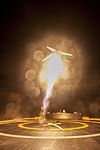 |
| 9 | 27 May 2016 | Thaicom 8 | SpaceX landed the first stage of a Falcon 9 on OCISLY during the Thaicom 8 mission, its third time successfully landing on a drone ship at sea.[64] | Success (Drone ship) | 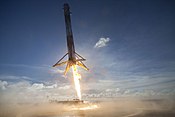 |
| 10 | 15 June 2016 | ABS-3A/Eutelsat 115 West B | SpaceX failed to land the first stage of the Falcon 9 on OCISLY during the Asia Broadcast Satellite/Eutelsat mission.[65] Elon Musk tweeted that one of the three engines had low thrust, and when the rocket was just off the deck, the engines ran out of oxidizer.[66] | Failure (Drone ship) | |
| 11 | 14 August 2016 | JCSAT-16 | Falcon 9's 28th flight propelled the Japanese JCSAT-16 telecommunications satellite to a geosynchronous transfer orbit on 14 August 2016. The first stage re-entered the atmosphere and during the night landed vertically on OCISLY, positioned in the Atlantic Ocean nearly 400 miles from the Florida coastline; unlike previous successful landings, this landing-burn only used one engine, not three.[67] | Success (Drone ship) | 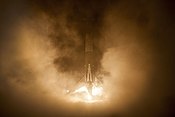 |
| 12 | 14 January 2017 | Iridium NEXT-1 | The Falcon 9 first stage landed on the Pacific Ocean ASDS JRtI during the Iridium NEXT-1 mission.[68][69] This marked the first successful landing on JRtI and the first landing in the Pacific Ocean.[41][70] | Success (Drone ship) | 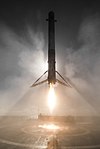 |
| 13 | 30 March 2017 | SES-10 | The Falcon 9 first stage landed on OCISLY during the SES-10 launch. This was the first successful launch and landing of a previously flown orbital booster. | Success (Drone ship) | 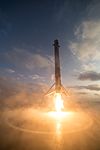 |
| 14 | 23 June 2017 | BulgariaSat-1 | The Falcon 9 first stage landed on OCISLY during the BulgariaSat-1 launch. This was the second successful launch and landing of a previously flown orbital booster. This was also the first booster to have landed on both active drone ships. While the landing was considered a success, the booster was "slammed sideways" and suffered a 'hard landing' which resulted in 'most of the emergency crush core being used'. | Success (Drone ship) | 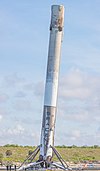 |
| 15 | 25 June 2017 | Iridium NEXT-2 | The Falcon 9 first stage landed on JRtI during the Iridium launch. | Success (Drone ship) | |
| 16 | 24 August 2017 | FORMOSAT-5 | The Falcon 9 first stage landed on JRtI during the FORMOSAT-5 launch. | Success (Drone ship) |  |
| 17 | 9 October 2017 | Iridium NEXT-3 | The Falcon 9 first stage landed on JRtI during the Iridium launch. | Success (Drone ship) | |
| 18 | 11 October 2017 | SES-11 | The Falcon 9 first stage landed on OCISLY during the SES-11 launch. | Success (Drone ship) | |
| 19 | 30 October 2017 | Koreasat 5A | The Falcon 9 first stage landed on OCISLY during the Koreasat 5A mission. | Success (Drone ship) | |
| 20 | 6 February 2018 | Falcon Heavy Test Flight | On 6 February 2018, the central core from the Falcon Heavy Test Flight attempted a landing on OCISLY. There was not enough TEA-TEB igniter remaining and only the centermost of the three engines required ignited during the landing burn. The core hit the water near the drone ship at over 300 mph and was destroyed. The explosion of the central core upon impact also damaged two of the thrusters on the drone ship. The side boosters successfully landed at Landing Zones 1 and 2. The loss of the central core did not impact SpaceX operations since it was from an older generation of the Falcon 9 not intended to be reused.[18] | Failure (Drone ship) | |
| 21 | 6 March 2018 | Hispasat 30W-6 | On 6 March 2018, a Falcon 9 Full Thrust carrying the Hispasat 30W-6 communications satellite for Hispasat of Spain was originally supposed to attempt a landing, as the first stage was programmed to do the landing. However, due to sea conditions considered to be unfavorable, the drone ship was left at the port. The first stage did its pre-programmed maneuvers, but did not attempt to land.[71] | No attempt | |
| 22 | 18 April 2018 | TESS | The Falcon 9 first stage landed on OCISLY during the TESS mission and was the 13th successful drone ship-based recovery.[72] | Success (Drone ship) | |
| 23 | 11 May 2018 | Bangabandhu-1 | The Falcon 9 Block 5 first stage landed on OCISLY during the Bangabandhu-1 mission and was the first flight of a Block 5 booster and upper stage. It was the overall 25th successful recovery of a booster. | Success (Drone ship) | |
| 24 | 22 July 2018 | Telstar 19V | The Falcon 9 first stage landed on OCISLY during the Telstar 19V mission. | Success (Drone ship) | |
| 25 | 25 July 2018 | Iridium 7 | The Falcon 9 first stage landed on JRtI during the Iridium 7 mission. | Success (Drone ship) | |
| 26 | 7 August 2018 | Merah Putih | Falcon 9 first stage landed on OCISLY during the Merah Putih mission. | Success (Drone ship) | |
| 27 | 15 November 2018 | Es’hail-2 | Falcon 9 first stage landed on OCISLY during the Es’hail-2 mission. | Success (Drone ship) | 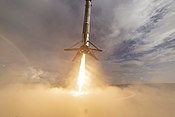 |
| 28 | 3 December 2018 | SSO-A | Falcon 9 block 5 first stage landed on JRtI during the Spaceflight SSO-A mission and was the first time that a booster landed 3 times. | Success (Drone ship) | 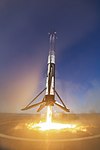 |
| 29 | 11 January 2019 | Iridium 8 | Falcon 9 block 5 first stage B1049 landed on JRtI during the Iridium 8 mission. | Success (Drone ship) | |
| 30 | 22 February 2019 | Nusantara Satu/Beresheet/ S5 | Falcon 9 block 5 first stage B1048 landed on OCISLY during the Nusantara Satu, Beresheet & S5 mission. | Success (Drone ship) | 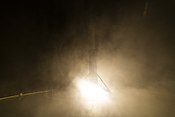 |
| 31 | 2 March 2019 | SpX-DM1 | Falcon 9 block 5 first stage B1051.1[73] landed on OCISLY during the SpX-DM1 (SpaceX Demonstration Mission 1). | Success (Drone ship) | 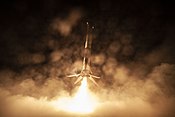 |
| 32 | 11 April 2019 | Arabsat-6A | Falcon Heavy block 5 first stage's center booster B1055.1 landed on OCISLY. This was the first successful landing of a center booster used in a Falcon Heavy rocket. The side boosters also landed on their respective ground pads.[74] However, the recovery team was unable to secure the center booster onto the drone ship due to rough seas and the core was lost at sea.[75] | Success (Drone ship) |  |
| 33 | 4 May 2019 | SpaceX CRS-17 | Falcon 9 first stage B1056.1 landed on OCISLY during the SpaceX CRS-17 mission. The landing was originally scheduled for Landing Zone 1, but was switched after an explosion in a test of a Crew Dragon capsule at LZ1.[76] The launch of CRS-17 was delayed due to generator issues on the drone ship.[77] | Success (Drone ship) | |
| 34 | 24 May 2019 | Starlink v0.9 | Falcon 9 first stage B1049.3 landed on OCISLY during the Starlink mission to launch 60 satellites.[78] | Success (Drone ship) | |
| 35 | 25 June 2019 | Space Test Program Flight 2 | Falcon Heavy center core from the STP-2 mission failed to land on the OCISLY due to lack of control from a failure with the thrust vectoring control in the center engine; the side cores landed successfully on ground pads.[79] | Failure (Drone ship) | |
| 36 | 11 November 2019 | Starlink F1 v1.0 | Falcon 9 first stage B1048.4 landed on OCISLY during the second large batch Starlink mission to launch 60 satellites. This was the first time that a Falcon 9 booster made a fourth flight and landing.[80] | Success (Drone ship) | |
| 37 | 5 December 2019 | SpaceX CRS-19 | Falcon 9 first stage B1059.1 successfully landed on OCISLY following the launch of the SpaceX CRS-19 commercial resupply mission. It was the first flight and landing for this booster.[81] | Success (Drone ship) |
See also
- Blue Origin landing platform ship
- List of Falcon 9 and Falcon Heavy launches
- Ms. Tree
- NASA recovery ship
- Reusable launch system
- Vertical Take-off, Vertical Landing
References
- ^ @elonmusk (12 January 2016). "Aiming to launch this weekend and (hopefully) land on our droneship. Ship landings needed for high velocity missions" (Tweet) – via Twitter.
- ^ @elonmusk (17 January 2016). "If speed at stage separation > ~6000 km/hr. With a ship, no need to zero out lateral velocity, so can stage at up to ~9000 km/h" (Tweet) – via Twitter.
- ^ a b c d e Harwood, William (16 December 2014). "SpaceX readies rocket for station launch, barge landing". CBS News. Retrieved 23 December 2014.
A 300-foot-long barge will be used as an off-shore landing platform during launch of a SpaceX Falcon 9 rocket Friday. The primary goal of the flight is to deliver critical supplies and equipment to the space station, but SpaceX hopes to land the rocket's first-stage on the barge for possible refurbishment and reuse – a key milestone in the company's push to reduce launch costs.
- ^ SpaceX Dragon Headed to the ISS. 8 April 2016 – via YouTube.
- ^ a b c d e f Bergin, Chris (24 November 2014). "SpaceX's Autonomous Spaceport Drone Ship ready for action". NasaSpaceFlight.com. Retrieved 24 November 2014.
- ^ a b Foust, Jeff (25 October 2014). "Next Falcon 9 Launch Could See First-stage Platform Landing". Space News. Retrieved 25 October 2014.
- ^ a b c Bullis, Kevin (26 October 2014). "SpaceX Plans to Start Reusing Rockets Next Year". MIT Technology Review. Retrieved 25 October 2014.
- ^ a b Musk, Elon (22 November 2014). "Autonomous spaceport drone ship". SpaceX. Retrieved 23 November 2014.
- ^ "DRAFT Environmental Assessment for the Space Exploration Technologies Vertical Landing of the Falcon Vehicle and Construction at Launch Complex 13 at Cape Canaveral Air Force Station Florida" (PDF). U.S. Air Force. October 2014. p. 17. Archived from the original (PDF) on 8 January 2015. Retrieved 8 January 2015.
- ^ Clark, Stephen (16 December 2014). "Photos: SpaceX's autonomous spaceport drone ship". Spaceflight Now. Retrieved 16 December 2014.
- ^ Musk, Elon (23 January 2015). "Repairs almost done..." Twitter.com.
- ^ a b c Musk, Elon (23 January 2015). "West Coast droneship under construction..." Twitter.com.
- ^ a b Musk, Elon (29 January 2015). "Painting the name on the droneship..." Twitter.com.
- ^ Wall, Mike. "Elon Musk Names SpaceX Drone Ships in Honor of Sci-Fi Legend". Space.com. Retrieved 30 June 2015.
- ^ a b c d e f g h Smedley, Jesse (18 June 2015). "SpaceX Augments and Upgrades Drone Ship Armada". NASASpaceFlight.com. Retrieved 18 June 2015.
- ^ SpaceX to attempt five recoveries in less than two weeks as fleet activity ramps up, NASAspaceflight.com, 19 July 2018, accessed 2 August 2018.
- ^ "SpaceX Rocket Makes Spectacular Landing on Drone Ship". Phenomena. Retrieved 10 April 2016.
- ^ a b SpaceX (6 February 2018). "Space X News Conference". youtube.com. Retrieved 6 February 2018.
- ^ "SpaceX's drone ship fleet spied prepping for future rocket recoveries". Teslarati.com. 26 March 2018. Retrieved 27 March 2018.
- ^ "Just Read the Instructions". SpaceXFleet. Retrieved 9 December 2019.
- ^ "SpaceX Planning To Base Rocket, Spacecraft Retrieval at Port of Los Angeles". CBS Los Angeles. 18 June 2015. Retrieved 18 June 2015.
- ^ Littlejohn, Donna (18 June 2015). "Groundbreaking partnership announced between SpaceX and AltaSea in San Pedro". Redlands Daily Facts. Retrieved 19 June 2015.
- ^ Graham, William (17 January 2016). "SpaceX Falcon 9 v1.1 set for Jason-3 launch". NASASpaceFlight.com. Retrieved 17 January 2016.
For the barge that will be used, an ASDS based on the Marmac 303 barge and bearing the name Just Read the Instructions, it will be the first recovery attempt. The name "Just Read the Instructions", an homage to the literary works of Iain M. Banks, was previously borne by the first ASDS, based on the Marmac 300 barge.
- ^ Pasztor, Andy (17 January 2016). "SpaceX Stumbles, as Booster Landing Fails". Wall Street Journal. Retrieved 19 January 2016.
- ^ SpaceX returns to flight, nails rocket landing CNN, Retrieved 14 January 2017
- ^ a b Template:Cite news=https://www.teslarati.com/spacex-sends-falcon-9-west-coast-drone-ship-east/
- ^ a b Kelly, Emre (12 February 2018). "Elon Musk: New SpaceX drone ship, A Shortfall of Gravitas, coming to East Coast". Florida Today. Retrieved 13 February 2018.
- ^ Musk, Elon (27 July 2018). "Probably ships next summer". Twitter.com.
- ^ Evans, Ben (January 2015). "SpaceX Autonomous Spaceport Drone Ship Sets Sail for Tuesday's CRS-5 Rocket Landing Attempt". AmericaSpace. Retrieved 9 April 2015.
- ^ a b Johnson, Scott (25 November 2014). "SpaceX CRS-5: Grid-Fins and a Barge". Spaceflight Insider. Retrieved 4 January 2015.
- ^ "MARMAC 300 (1063184)". Boat Database. Retrieved 17 December 2014.
- ^ Dean, James (24 October 2014). "SpaceX to attempt Falcon 9 booster landing on floating platform". Retrieved 27 October 2014.
- ^ "SpaceX Announces Spaceport Barge Positioned by Thrustmaster's Thrusters". Thrustmaster. 22 November 2014. Archived from the original on 7 December 2014. Retrieved 23 November 2014.. Additional archives: 23 November 2014.
- ^ a b Bergin, Chris (18 November 2014). "Pad 39A – SpaceX laying the groundwork for Falcon Heavy debut". NASA Spaceflight. Retrieved 17 November 2014.
- ^ .Shotwell, Gwynne (3 February 2016). Gwynne Shotwell comments at Commercial Space Transportation Conference. Commercial Spaceflight. Event occurs at 2:43:15–3:10:05. Retrieved 4 February 2016.
Those are GoPro cameras by the way, unbelievable technology. We fly many of them. ... Our third attempt to land on a drone ship ... this past January ... we did stick the landing, we stuck it and then we unstuck it. ... I love these videos. I think these videos are great! You learn so much from this activity. ... for all of you curmudgeons who say that was a failure, you're totally wrong. We landed. We broke a leg. We learned a little bit. And we're going to land again. ... this is the previous version of the rocket. The landing legs weren't quite as robust ... from a previous design era.
- ^ Chris Bergin (24 November 2014). "SpaceX's Autonomous Spaceport Drone Ship ready for action". NASA Spaceflight.com.
- ^ "Learn to tell science stories". Editorial. Nature. 555 (7695): 141–2. 7 March 2018. doi:10.1038/d41586-018-02740-5. PMID 29517034.
- ^ Cofield, Calla (9 April 2016). "SpaceX Sticks a Rocket Landing at Sea in Historic First". Scientific American. Space.com.
- ^ Elon Musk [@elonmusk] (12 February 2018). "A Shortfall of Gravitas" (Tweet) – via Twitter.
- ^ "Iain M Banks Q&A". Guardian. 11 September 2000. Retrieved 9 March 2009.
- ^ a b "SpaceX rocket docks at San Pedro home port after successful mission". dailynews.com. 17 January 2017. Retrieved 31 January 2017.
- ^ "SpaceX Autonomous Spaceport Drone Ship Sets Sail for Tuesday's CRS-5 Rocket Landing Attempt". AmericaSpace. 4 April 2015. Retrieved 20 December 2017.
- ^ Bergin, Chris (12 April 2016). "Falcon 9 first stage sails into Port Canaveral atop ASDS – ahead of big plans". nasaspaceflight.com. Retrieved 16 January 2017.
- ^ 29 June 2017 SpaceX debuts ‘Optimus Prime’ Robot, successfully recovers Falcon 9 1029 for the second time Teslarati
- ^ "Photos of Falcon 9 B1029.2 entering Port Canaveral, with the roomba visible beneath the rocket. Credit: Michael Seeley / We Report Space • r/spacex". reddit. Retrieved 31 December 2017.
- ^ Bergin, Chris (17 December 2014). "SpaceX confirms CRS-5 launch slip to 6 January". NASASpaceFlight.com. Retrieved 18 December 2014.
- ^ a b Clark, Stephen (10 January 2015). "Dragon successfully launched, rocket recovery demo crash lands". Spaceflight Now. Retrieved 10 January 2015.
- ^
- Musk, Elon (10 January 2015). "Rocket made it to drone spaceport ship..." Twitter.com.
- Musk, Elon (10 January 2015). "Ship itself is fine..." Twitter.com.
- Musk, Elon (10 January 2015). "Didn't get good landing/impact video..." Twitter.com.
- ^ Musk, Elon (11 February 2015). "Rocket soft landed in the ocean..." Twitter.com.
- ^ Musk, Elon (14 April 2015). "Ascent successful..." Twitter.com.
- ^ Musk, Elon (14 April 2015). "Looks like Falcon landed fine..." Twitter.com.
- ^ Harwood, William (28 June 2015). "SpaceX Falcon 9 rocket destroyed in launch mishap". CBS News. Retrieved 28 June 2015.
- ^ "SpaceX Plans Drone Ship Rocket Landing for Jan. 17 Launch", NBC News, 7 January 2016, accessed 12 January 2016.
- ^ Jason-3 Hosted Webcast. SpaceX. 17 January 2016. Event occurs at 1:06:30 (25:20 after lift-off). Retrieved 17 January 2016.
- ^ tweet from SpaceX official twitter account after announcement on livestream
- ^ "Elon Musk on Twitter". Twitter.
- ^ Boyle, Alan (17 January 2016). "SpaceX rocket launches satellite, but tips over during sea landing attempt". GeekWire. Retrieved 18 January 2016.
- ^ "SpaceX: ice buildup may have led rocket to tip over". Washington Post. 18 January 2016. Retrieved 18 January 2016.
Musk tweeted that the lockout collet on one of the rocket's four legs didn't latch, causing it to tip over after landing. He said the "root cause may have been ice buildup due to condensation from heavy fog at liftoff".
- ^ Elon Musk [@elonmusk] (5 March 2016). "Rocket landed hard on the drone ship. Didn't expect this one to work (v hot reentry), but next flight has a good chance" (Tweet) – via Twitter.
- ^ ASDS March 21, 2016 (OCISLY) YouTube
- ^ "Watch SpaceX achieve first-ever sea landing of reusable rocket". Los Angeles Times. 7 April 2016. Retrieved 14 April 2016.
- ^ a b Chris, Bergin (12 April 2016). "Falcon 9 first stage sails into Port Canaveral atop ASDS – ahead of big plans". NASA Spacefight. Retrieved 13 April 2016.
- ^ SpaceX successfully lands its Falcon 9 rocket on a floating drone ship again The Verge, Retrieved 6 May 2016.
- ^ SpaceX lands fourth booster after successful Falcon 9 launch Florida Today, Retrieved 27 May 2016.
- ^ Live coverage: Pioneering telecom satellites launching today on Falcon 9 Spaceflightnow Retrieved 15 June 2016.
- ^ "Elon Musk on Twitter". Twitter. Retrieved 15 June 2016.
- ^ Clark, Stephen (14 August 2016). "Falcon 9 rocket launches Japanese satellite, then nails bullseye landing". Spaceflight Now.
- ^ "First stage has landed on Just Read the Instructions – SpaceX on Twitter". Twitter. Retrieved 14 January 2017.
- ^ CNN, Azadeh Ansari and Jackie Wattles. "SpaceX returns to flight, nails rocket landing". CNN. Retrieved 14 January 2017.
{{cite web}}:|last=has generic name (help) - ^ SpaceX (14 January 2017), Iridium-1 Hosted Webcast (at 37:30), retrieved 14 January 2017
- ^ SpaceX (5 March 2018). "Hispasat 30W-6". youtube.com. Retrieved 3 April 2018.
- ^ "SpaceX rocket test-fired at Cape Canaveral for NASA telescope launch". 11 April 2018. Retrieved 14 April 2018.
- ^ "Prelaunch Preview – SpaceX Demonstration Mission 1". Everyday Astronaut. 28 February 2019. Retrieved 2 March 2019.
- ^ "SpaceX Falcon Heavy launches Arabsat-6A". 11 April 2019. Retrieved 11 April 2019.
- ^ "SpaceX's Center Core Booster for Falcon Heavy Rocket Is Lost at Sea". 15 April 2019. Retrieved 16 April 2019.
- ^ Stephen Clark (23 April 2019). "SpaceX likely to move next rocket landing to drone ship". Spaceflight Now. Retrieved 5 May 2019.
- ^ Ralph, Eric (3 May 2019). "SpaceX scrubs Cargo Dragon, Falcon 9 launch due to drone ship power issue". TESLARATI. Retrieved 9 May 2019.
- ^ Clark, Stephen. "SpaceX's first 60 Starlink broadband satellites deployed in orbit – Spaceflight Now".
- ^ Ralph, Eric (26 June 2019). "SpaceX CEO Elon Musk explains why Falcon Heavy's center core missed the drone ship". TESLARATI. Retrieved 26 June 2019.
- ^ @SpaceX (11 November 2019). "Falcon 9 first stage has landed on the of Course I Still Love You droneship – the fourth launch and landing of this booster" (Tweet) – via Twitter.
- ^ "Falcon 9 launches Dragon cargo spacecraft to ISS". 5 December 2019. Retrieved 5 December 2019.
